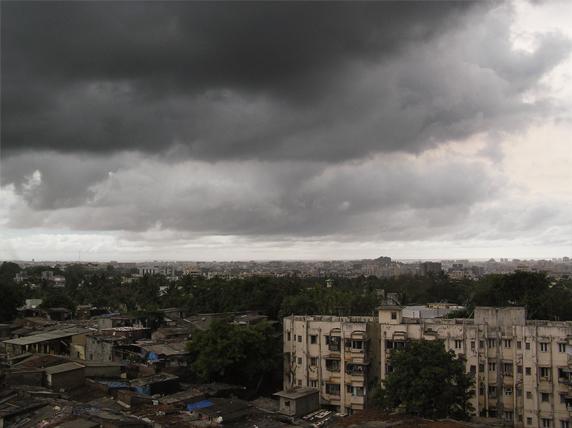Indian meteorologists trying to develop more precise forecasts of critical monsoon rains
A monsoon builds over Mumbai in India. Monsoon rains have been sparse in India this year. (Photo by Enygmatic-Halycon via Wikimedia Commons.)
Over half of people in India depend on farming for their livelihood. It’s been a tough and economically insecure job this year.
Less than half of Indian farmland is irrigated, so the annual monsoon is crucial. This year, the monsoon came late, and has been sparse in much of the northern agricultural belt, leaving cracked fields and stunted crops.
Indian scientists have teamed up with colleagues from the United States and the United Kingdom to build new computer models to help predict the movements of erratic monsoons — to crack the code of when the monsoons will fall, and where.
That moment can’t come soon enough for Debashish Sarkar, a small-time farmer in India.
Every now and then he looks up to the skies, hoping they will open up. Without the much-needed rains, he knows his three acres of mustard and rice fields will almost certainly fail. Small landowners like Sarkar are totally dependent on the monsoons.
Without the seasonal rains, his very livelihood is at risk.
“Even this year, it looks as if there are going to be no rains,” he said. “Until July, the rains have been scarce. This time too, the villagers are bound to suffer.”
He’s expecting his crops to be a total loss.
India’s Institute of Tropical Meteorology, based in the western city of Pune, is working on a multi-million dollar National Monsoon Mission. The project aims to forecast extreme climate events, such as drought and floods, active and dry spells of monsoon, and more importantly, collect data on how rain will fall across the country.
M. Rajeevan, an advisor to the Ministry of Earth Sciences is overseeing the project that is hoped to drastically improve the economic prospects of about 600 million people in India, whose lives depend directly on the agricultural sector.
“The farming community needs longer forecasts than the medium range. That means forecasts from seven days to a range of one month. These forecasts aren’t being generated at the moment,” Rajeevan said.
S. C. Bhan, the Indian Meteorological Department, deputy director general, said the new effort will include a more dynamic forecasting model, based on work done in the United States.
“The farmers will be able to make use of this information in terms of planning the seasonal aspects of their different crops: what to sow, when to sow, how much proportion and percentage of different crops,” he said.
The goal is also to give them information they can use to make decisions about when and how much irrigation to do, helping to drive down costs.
K. Basu, India’s former Agriculture Secretary, who retired a few months ago, says the new model is critical to the future of the agricultural sector, which employs about half of the country’s population.
“India feeds 17 percent of the world’s population with its 1.2 billion population, with just 4.3 (percent) of the water that the world gets,” Basu said. “So, we have a huge task on our hands, and any mistake that we make on the monsoons is extremely costly.”
While it will be an advantage to know when the rains will fall, the government will also have to ensure that farmers get the right crop varieties on time as well.
In the past 130 years, the meteorological department has never been able to forecast a drought. Not in 1987, 2002, 2004 or 2009. Each time it predicted normal or near normal rainfall. In the past 12 years, the closest the department has come to a correct forecast was in 2005 when it predicted 98 percent rainfall and the actual level was 98.8 percent.
In 2002, it forecast 101 percent rainfall, and the country received only 79.4 percent.
This year, the government has banked on a normal monsoon to boost weak economic growth. But so far, the reality has once again fallen short of everyone’s expectations.
